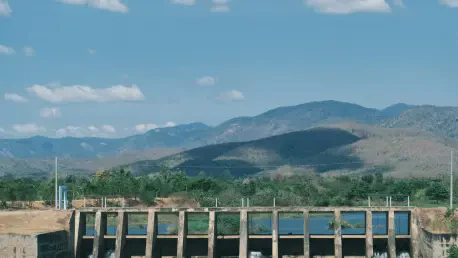The Grand Ethiopian Renaissance Dam (GERD), towering over the Blue Nile River, represents far more than a feat of engineering; it embodies Ethiopia’s relentless pursuit of economic transformation and energy self-sufficiency in a region marked by both potential and peril. Costing an estimated $4 billion and under construction for over a decade since breaking ground in 2011, this colossal project is Africa’s largest hydroelectric dam, designed to revolutionize Ethiopia’s power landscape by generating enough electricity to light up millions of lives. Yet, as the dam nears its anticipated inauguration in September 2025, it has also become a flashpoint for regional discord, particularly with downstream neighbors Egypt and Sudan, whose dependence on the Nile’s waters fuels fears of scarcity and loss. This article delves into the intricate dance between Ethiopia’s developmental ambitions and the pressing need for regional stability, examining whether the GERD can serve as a bridge to prosperity or a wedge deepening divisions in the Horn of Africa.
Ethiopia’s Bold Leap Toward Progress
The GERD stands as a monumental pillar of hope for Ethiopia, a country where nearly half of its 130 million citizens—around 60 million people—still live without access to electricity, grappling with the daily challenges of an underpowered economy. With a projected capacity of 5 gigawatts annually, the dam is set to double Ethiopia’s current energy output, promising to connect countless households and businesses to the national grid. This surge in power could ignite industrial growth, improve living standards, and reduce reliance on inconsistent energy sources. Prime Minister Abiy Ahmed has championed the project as a cornerstone of national pride, with construction reaching 94.6% completion by early 2024. The anticipated economic boost from meeting domestic needs alone underscores the dam’s transformative potential for a nation eager to shed the constraints of energy poverty and step boldly into a modern era.
Beyond lighting homes, the GERD offers Ethiopia a chance to redefine its economic role in the region through energy exports, with projections estimating annual revenues of $1 billion from selling electricity to neighboring countries. This financial windfall could fund further infrastructure projects, reinforcing Ethiopia’s vision of becoming a regional powerhouse. The dam’s benefits extend to job creation during and after construction, as well as enhanced agricultural productivity through better irrigation systems. As the inauguration looms in September 2025, the project symbolizes not just technological achievement but a strategic pivot toward economic diplomacy. However, realizing these gains depends on navigating the geopolitical currents swirling around the Nile, where Ethiopia’s aspirations collide with the vital interests of other nations, testing the limits of cooperation in a historically tense landscape.
A Continental Beacon with Global Echoes
The GERD’s impact reverberates far beyond Ethiopia’s borders, positioning it as a flagship for Africa’s broader quest for energy security and sustainable development in an era of rapid urbanization and climate challenges. As a model for large-scale hydroelectric initiatives, it parallels ambitions like the Grand Inga Dam project, signaling a continental shift toward harnessing natural resources for collective progress. The dam’s capacity to mitigate devastating floods, improve irrigation for food security, and generate surplus power for export could reshape regional economies, knitting closer ties through shared benefits. For Ethiopia, becoming an energy exporter enhances its stature as a leader, potentially inspiring other African nations to pursue similar infrastructure dreams with an eye on long-term stability and growth.
Yet, the GERD’s continental significance is a double-edged sword, as its success hinges on addressing cross-border concerns that could either unite or fracture regional alliances. While Ethiopia envisions the dam as a catalyst for integration, the project’s implications for water distribution along the Nile introduce risks that could undermine its broader promise. The challenge lies in ensuring that the benefits of increased energy and economic opportunities are not overshadowed by disputes over shared resources. As Africa watches this unfolding story, the GERD serves as a critical case study in balancing national development with the imperatives of regional harmony, offering lessons that could shape future infrastructure endeavors across the continent. The stakes are high, as the outcome may influence how African nations approach the delicate interplay of ambition and collaboration.
Water Security: A Source of Regional Strife
The GERD’s strategic placement on the Blue Nile has ignited a firestorm of tension with downstream nations, particularly Egypt and Sudan, whose livelihoods and economies are inextricably tied to the river’s uninterrupted flow. Egypt, sourcing 97% of its water from the Nile for agriculture and domestic use, perceives the dam as a direct threat to its very survival, fearing reductions in water availability that could cripple farming and exacerbate scarcity. Sudan, though potentially gaining from regulated flooding and access to affordable electricity, remains apprehensive about diminished water volumes and the operational safety of the structure. Despite years of diplomatic efforts, including a high-profile meeting in Cairo in October 2023, no binding agreement has emerged, leaving the region teetering on the edge of conflict as the dam’s completion draws near.
These unresolved disputes over water security highlight the GERD’s role as a litmus test for managing shared resources in a region where the Nile is a lifeline for millions across multiple borders. Ethiopia staunchly defends its sovereign right to utilize the Blue Nile for national development, arguing that the dam addresses critical energy deficits without significantly harming downstream flows. However, Egypt and Sudan demand concrete assurances and operational guidelines to protect their water allocations, a standoff that has resisted mediation by international bodies like the African Union. The absence of consensus as the September 2025 inauguration approaches amplifies anxieties, raising the specter of escalated tensions or even conflict. The situation underscores a fundamental challenge: reconciling Ethiopia’s legitimate growth aspirations with the existential needs of its neighbors in a zero-sum perception of water politics.
Environmental Risks Threatening Longevity
Apart from geopolitical friction, the GERD faces substantial environmental hurdles that could jeopardize its sustainability and the economic dividends it promises to deliver over decades. A primary concern is sedimentation within the vast reservoir, a natural process that risks reducing the dam’s storage capacity and operational lifespan if not addressed through proactive measures. Strategies such as releasing turbid density currents or implementing robust land management practices in the surrounding watershed to minimize erosion are essential to counteract this threat. Given the dam’s pivotal role in Ethiopia’s energy strategy, overlooking these ecological challenges could erode the very foundation of its intended social and economic benefits, turning a symbol of progress into a costly liability.
Tackling these environmental risks requires not just technical solutions but a commitment to long-term planning and regional cooperation, as the health of the Blue Nile’s ecosystem affects all countries in its basin. Sedimentation and related issues are not unique to the GERD; they reflect broader challenges faced by large-scale hydroelectric projects across the globe, where balancing infrastructure with nature remains a persistent dilemma. Ethiopia must prioritize sustainable practices to ensure the dam’s viability, as failure to do so could diminish public and international confidence in the project. Moreover, addressing these concerns transparently could serve as a trust-building measure with downstream nations, potentially easing diplomatic tensions. The environmental dimension adds yet another layer of complexity to the GERD’s narrative, demanding foresight to secure its legacy as a driver of progress.
Navigating the Diplomatic Crossroads
With the GERD’s inauguration slated for September 2025, the urgency for a diplomatic resolution to the simmering regional dispute has never been greater, as the project’s completion marks a point of no return for Ethiopia and its neighbors. Ethiopia remains steadfast in asserting its right to harness the Blue Nile for development, viewing the dam as a non-negotiable pillar of its economic future. Conversely, Egypt and Sudan continue to seek ironclad guarantees that their water security will not be compromised, pushing for detailed agreements on the dam’s filling and operation. Despite interventions by global players like the United States and regional bodies like the African Union, the deadlock persists, casting a shadow over the region’s stability in the Horn of Africa and beyond.
The path forward demands innovative diplomacy to transform the GERD from a source of contention into a platform for mutual gain, where all parties can share in the benefits of energy and water management. A successful accord could set a precedent for cooperative resource management, turning the dam into a symbol of unity rather than division. However, failure to bridge these divides risks not only heightened conflict but also a missed opportunity to leverage the project for regional economic integration. The international community’s role in facilitating dialogue and providing technical expertise could prove decisive, yet the onus ultimately falls on the riparian states to prioritize compromise over confrontation. As the deadline looms, the GERD stands at a diplomatic crossroads, with its ultimate impact hanging on the ability to forge a shared vision.
Lessons for Africa’s Developmental Path
The GERD encapsulates a broader narrative of Africa’s struggle to harmonize ambitious development goals with the imperatives of regional cohesion and environmental stewardship in an increasingly interconnected world. As large-scale infrastructure projects proliferate across the continent, from dams to rail networks, the challenges of balancing national interests with collective well-being become ever more pronounced. The GERD’s trajectory offers critical insights into managing shared resources like water, where unilateral actions can spark ripple effects far beyond borders. Its outcome will likely influence how future initiatives are planned and executed, shaping policies on cross-border collaboration and sustainable growth in a region rich with potential but fraught with historical rivalries.
Reflecting on the GERD’s journey, it becomes clear that Africa’s path to progress requires a delicate equilibrium, where infrastructure serves as a unifier rather than a wedge between nations with competing needs. The dam’s story underscores the necessity of inclusive dialogue, where environmental considerations and downstream impacts are integral to project design from the outset. As a test case, the GERD challenges policymakers to rethink traditional approaches to development, advocating for frameworks that prioritize mutual benefits over isolated gains. Ultimately, whether the dam emerges as a triumph or a cautionary tale will depend on the commitment to sustained cooperation, providing a roadmap for navigating the complex interplay of growth and peace across the continent.









